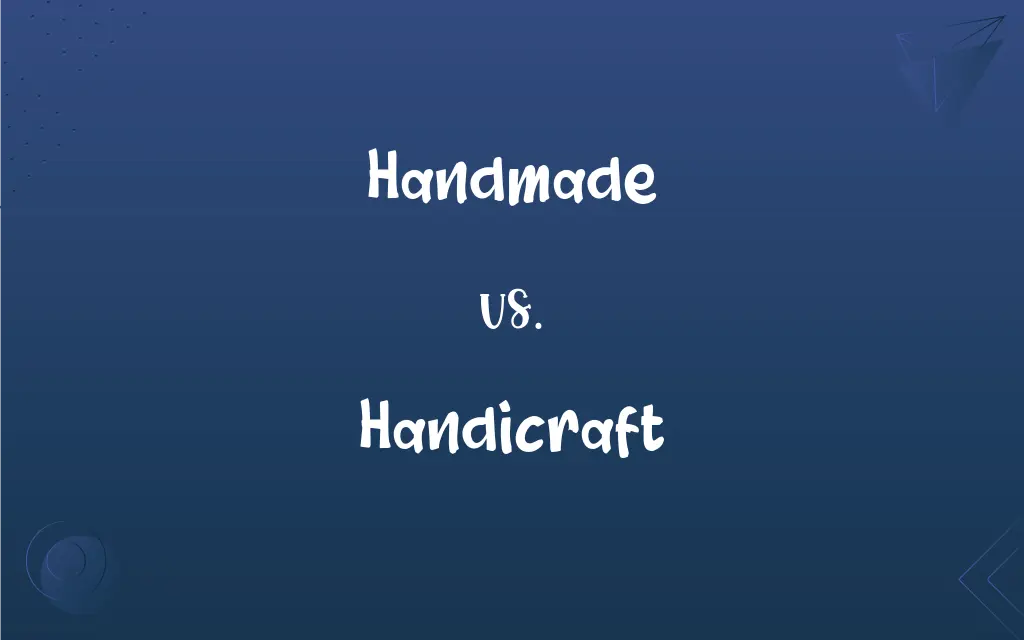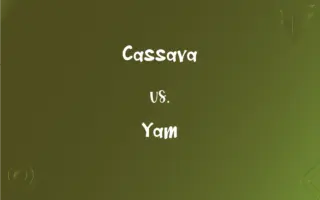Handmade vs. Handicraft: What's the Difference?
Edited by Harlon Moss || By Janet White || Published on December 11, 2023
Handmade refers to items individually crafted by hand, while handicraft involves skilled work to create decorative or functional objects, often reflecting cultural artistry.

Key Differences
Handmade items are personally crafted without the use of machines, offering uniqueness in each piece, whereas handicrafts are a type of handmade item, often with cultural, artistic, or traditional significance.
Handmade products can range from simple everyday items to complex creations, focusing on the individual maker's skill, while handicrafts often require specialized skills and are associated with artisanal or traditional crafts.
The term "handmade" emphasizes the method of production, highlighting the human touch in its creation. In contrast, "handicraft" not only refers to the method of production but also often to the preservation of traditional crafting techniques.
Handmade items can be modern or traditional, functional or decorative, reflecting a wide range of personal styles. Handicrafts, however, are typically associated with specific cultural or historical contexts and often have a collective identity.
The value of handmade items lies in their individuality and craftsmanship, while handicrafts are valued for their cultural significance and the preservation of traditional skills and designs.
ADVERTISEMENT
Comparison Chart
Definition
Items individually crafted by hand without machines
Skilled work creating decorative or functional objects reflecting cultural artistry
Skill Level
Can vary from basic to highly skilled
Usually involves specialized, often traditional, skills
Cultural Significance
May or may not have cultural significance
Often has cultural, historical, or traditional importance
Types of Products
Ranges from everyday items to unique artworks
Includes artisanal crafts, cultural artifacts
Value
Lies in uniqueness and personal craftsmanship
Found in the preservation of skills and cultural identity
ADVERTISEMENT
Handmade and Handicraft Definitions
Handmade
Crafted using individual skill and labor.
She wore a beautiful handmade necklace.
Handicraft
Skilled work in creating decorative or functional items.
The village is known for its traditional handicrafts.
Handmade
Often unique, not mass-produced.
Handmade gifts are special because of their personal touch.
Handicraft
Often reflects cultural or traditional artistry.
Handicrafts at the fair included beautiful woven baskets.
Handmade
Denotes items personally created by an artisan.
Each handmade item in the store was one-of-a-kind.
Handicraft
Artisanal craftwork, often with historical significance.
Local handicrafts are a window into the community's heritage.
Handmade
Reflects the individual craftsmanship of the maker.
The quality of his handmade furniture was exceptional.
Handicraft
Includes techniques passed down through generations.
She learned the handicraft of pottery from her grandmother.
Handmade
Made by hand, not by machine.
The handmade pottery had a unique charm.
Handicraft
Often associated with specific cultures or regions.
Tourists love to buy handicrafts as souvenirs of their travels.
Handmade
Made or prepared by hand rather than by machine.
Handicraft
Skill and facility with the hands.
Handmade
Manufactured by hand.
Handmade shoes
Handicraft
A craft or occupation requiring skilled use of the hands.
Handmade
An art or craft object made by hand.
Handmade
Manufactured by hand; as, handmade shoes. Contrasted with machine-made.
Handmade
Made by hand or a hand process;
Delicate handmade baby dresses
FAQs
What defines a handmade item?
A handmade item is created by an individual's skill and labor without machine intervention.
What's the significance of buying handmade items?
Buying handmade supports individual artisans and ensures unique, personalized products.
Can a machine-made item be considered handmade?
No, handmade items must be crafted without the use of machines.
What is a handicraft?
Handicraft refers to skilled work in making decorative or functional items, often with cultural significance.
Are all handicrafts handmade?
Yes, all handicrafts are handmade, but not all handmade items are considered handicrafts.
How does one identify a handmade item?
Look for unique characteristics, individual craftsmanship, and often a maker's mark.
Why are handicrafts important?
Handicrafts are important for preserving traditional skills and cultural heritage.
Are handmade items environmentally friendly?
Often, as they typically involve fewer industrial processes and can use sustainable materials.
Do handicrafts vary by region?
Yes, handicrafts often reflect the cultural and historical influences of the region where they are made.
Are handicrafts more expensive than mass-produced items?
Often, yes, due to the time, skill, and uniqueness involved in their creation.
Can handmade items be found in regular stores?
Yes, though they are more commonly found in artisan markets, craft fairs, and specialized boutiques.
Is it possible to learn handicraft skills?
Yes, many people learn handicraft skills through workshops, classes, or from family members.
Can handmade items be custom ordered?
Yes, many artisans create custom handmade items based on specific requests.
What is the impact of handicrafts on cultural preservation?
Handicrafts play a crucial role in preserving and passing down cultural traditions and techniques.
Why do people collect handicrafts?
People collect handicrafts for their aesthetic, cultural value, and as a form of investment in art.
Do handmade items have a longer lifespan?
They can, due to the quality of craftsmanship and the ability to repair them.
Are there international markets for handicrafts?
Yes, there is a significant international market for handicrafts, particularly those with unique cultural significance.
What materials are used in handicrafts?
Handicrafts can be made from a variety of materials, including wood, fabric, metal, and clay.
How do handicrafts contribute to the economy?
Handicrafts contribute by supporting artisans and small businesses, often boosting local economies.
Can handmade items be repaired or customized?
Yes, the individual nature of handmade items often allows for easier repair or customization.
About Author
Written by
Janet WhiteJanet White has been an esteemed writer and blogger for Difference Wiki. Holding a Master's degree in Science and Medical Journalism from the prestigious Boston University, she has consistently demonstrated her expertise and passion for her field. When she's not immersed in her work, Janet relishes her time exercising, delving into a good book, and cherishing moments with friends and family.
Edited by
Harlon MossHarlon is a seasoned quality moderator and accomplished content writer for Difference Wiki. An alumnus of the prestigious University of California, he earned his degree in Computer Science. Leveraging his academic background, Harlon brings a meticulous and informed perspective to his work, ensuring content accuracy and excellence.








































































